|
|
|
|
Revised: 8/99.
§145
It is said that the Mashiakh rose from the dead on the day of first
fruits: But every man in his own order: Mashiakh the firstfruits;
afterward they that are Mashikah's, at His coming (I Cor. 15:23).
First it is necessary to point out that this text does not say that the
Anointed One rose on the day of firstruits, or the day the sheaf was waved
in the Temple. It only means that Christ was among the first to be
raised from the dead. Paul calls Stephanas the firstfruits of Achaia
(I Cor. 16:15; cf. Rom. 16:5), which only means that he was among the first
converts, not that he was converted on the day of firstfruits. To
call someone, or something the "firstfruits," is only to say that it is
the first and best part. The emphasis is on the best part more than
on the first part. For, often the first part of the crop with respect
to time is not the best part.
§146
In fact, Mashiakh was not the first one raised from the dead with a glorified
body. Moshe was raised before Mashiakh, and is seen with him on the
Mount of Transfiguration with Aliyahu (Mt. 17:1-8). So the reference
to Mashikah as the "firstfruits" only means he is among the first and best
part, or that he is the best part in the resurrection.
§147
Nevertheless, the Christian world teaches that Christ was raised on the
day of firstfruits, in spite of the fact that the scripture does not say
as much. But let us see just how far the Sabbath Resurrection can
accommodate this gratuitous assumption, that Yayshua is the first sheaf
of the resurrection harvest.
§148
First, the day of firstfruits is after the Passover Rest Day (Lev. 23:11),
which is called the Sabbath, meaning the first day of unleavened bread
or the 15th of Aviv. The Christians and Sadducees have confused this
special high day Sabbath (John 19:31) with the weekly Sabbath, but the
Pharisees and Rabbis of the Temple Period held the correct view and vigorously
prevented the Sadducees from corrupting the calendar. Yayshua, of
course, instructed us to follow the Pharisees teaching (Mt. 23:1-3).
§149
So, the day of firstfruits was the day after the Passover Sabbath.
Now the Passover Sabbath was from sunset Wednesday to sunset Thursday (3/24/34
c.e. to 3/25/34 c.e.). Now the day part of firstfruits would be dawn
Friday to dusk Friday. According to tradition, the sheaf was cut
just after sunset beginning the 16th of Aviv, however, the sheaf was not
waved until the next day by the Cohanim in the Temple.
§150
On, the other hand, Yayshua came out of the grave less than 12 hours after
the close of the standard firstfruits day, viz. prior to Saturday
morning before sunrise, before the day part of Sabbath had begun (though
the sabbath had begun), so clearly his coming out of the grave is at least
associated with the night following the standard firstfruits day.
§151
Yosayf Ben Mattityahu (Josephus) also informs us that the firstfruits day
was the day after the Passover Rest Day, and not the weekly Sabbath, "But
on the second day of unleavened bread, which is the sixteenth day of the
month, they first partake of the fruits of the earth, for before that day
they do not touch them. ... They offer the first fruits of their
barley" (Ant. 3.10.5).
§152
Is this is as close as we can come in associating the actual time of the
resurrection with the standard firstfruits day? Must it also
be recognized that the scripture does not say that Yayshua rose on
the actual day of firstfruits? What the scripture does say is that
the women came "On the first of the sabbaths," making the sabbath
a type of redemption as well as a type or rememberance of creation.
It also says he rose 'on the third day.'
§153
The day of firstfruits, or the wave sheaf, is the first day in the counting
of the omer (the 50 days) to Pentecost. In the second Temple period,
this was always the 16th day of Aviv [Nisan].
§153.1
Many of the Messianic Jewish Congregations hold to a Sabbath afternoon
Resurrection, which I should point out does not place the Ressurection
on the day of firstfruits by any acceptable Jewish computation. But
there two ways to do it with out view, retain the first of the sabbaths,
and eat your cake too. The first, which I do not favor, requires
a bit of Rabbinic reasoning:
The Sabbath .... began with the evening. For the Rabbis too, this was self evident; a day began with nightfall and ended prior to the start of the next night. However, the point of transition between two days was not clear and unambiguous: separating two successive days was a period called 'twilight'So the Rabbinic solution for those who want to maintain that the Resurrection was on the day of firstfruits is to place the Resurretion just after sunset Friday night, which is the tail end of the 16th of Aviv or Firstfruits day, yet is still on the first of the sabbaths after three days, and on the third day, and includes three nights. Such as senario is possible if we allow the Rabbinic reasoning sometimes called the three star rule, which I must point out is a valid definition of "day," since God "called the light 'day'", and that would last from dawn to dusk, viz. some time before sunrise and after sunset until full dark. See fig. 21.5:[literally: between the suns] or 'perhaps darkness, perhaps not'. The Rabbis were uncertain whether this period should be considered part of the day or part of the night, and they thus did not know to which of the two days it should be attributed (and, consequently, for some halakic purposes they considered this period as if it were part of both" (The Jewish People in the First Century, edited by S. Safrai and M. Stern with D. Flusser and W.C. van Unnik, Vol. 2 page 862 < Which day is the Passover?, by Phinehas Ben Zadok).
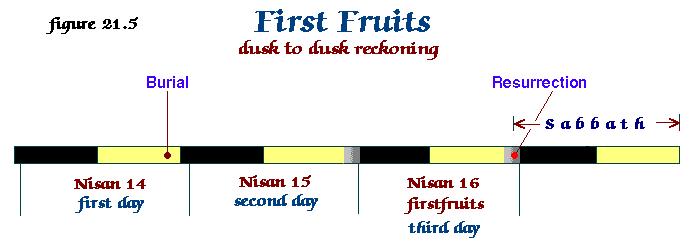
§153.2 Another solution requires the use of the common day (cf. §40). The common day may not have been popular with the Rabbis, who were busy maintaining the sanctity of the sabbaths, but it was probably the norm for the common people. The first common day after the Passover Sabbath would have begun at sunrise on Friday, and it would end at sunrise on the Sabbath, thus encompassing the resurrection. Let's take another look at the Passover sequence:
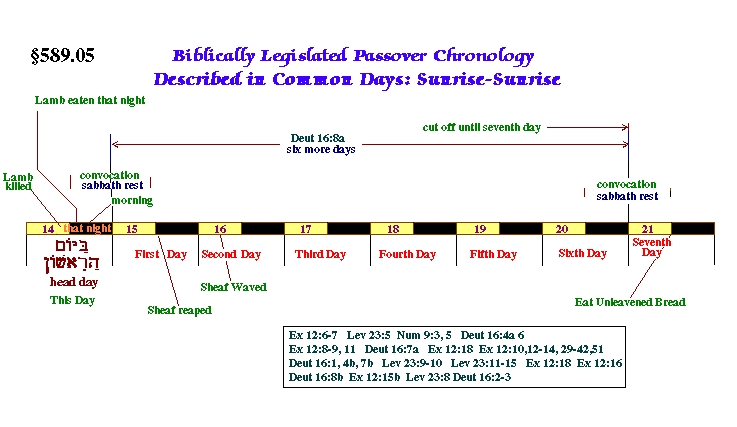
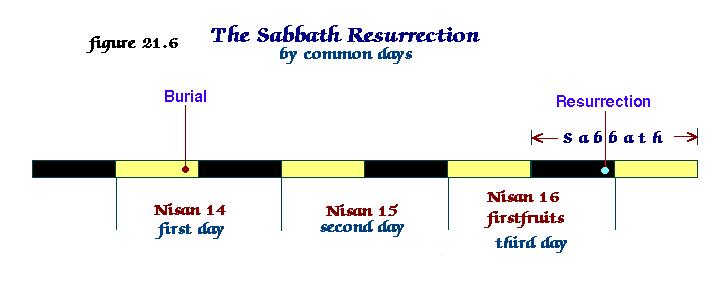
§153.301
Expanded Material (8/1999): I have up
to this point argued that the resurrection was in the morning on the sabbath,
while pointing out that the possible range of time was Friday dusk to Sabbath
dawn. After much study, and discussion, I have seen the
possibility of another modificiation which is not vulnerable to a number
of objections that are currently raised against the Sabbath Morning Resurrection.
Although I don't think the objections were ever valid, I think this
alternative should be offered to those who make the objections as a viable
view.
If we place the resurrection
between sunset and the extinction of light (i.e. during twilight) Friday
Evening, it will (1) Fall on the Sabbath, (2) Fall on the day of firstfruits
(dusk Thursday to dusk Friday), and fall on the day part of the third day
(dawn to dusk Friday). The only problem is that it would be
before the third night. But we must ask, "Did he say
that he would be dead three days and three nights?" No!
Not at all. He said that he would be in the heart of the earth
three days and three nights. Now the 'heart of the earth'
is the grave. For Yonah calls the whale's belly, "Sheol," i.e. the
grave. And this is what Yayshua meant. He would be in
the grave 'three days and three nights' (Mt. 12:40).
Yet he said that he would rise 'the third day.' Manifestly,
the third day proper, in the literal sense of 'dawn to dusk' (the light;
Ber. [Gen] 1:4) ends at the commencement of total dark Friday Night.
Therefore, to be on the third day, he would have to rise before total dark
Friday. On the other hand, according to Mat. 12:40 he
could not exit the grave until total dark, or else there would not be a
third night. So, let us suppose that he rose while it was still
day -- barely, and that he did not exit the grave until it was dark for
a while. In fact, he may have spent most of the night in the
grave, though not dead.
This in turn is
supported additional analysis of the phrase 'after three days.'
Apparently, when this phrase is turned back into Hebrew, the word 'after'
is 'miqats' (![]() ),
which means 'And at the end of.' For example, in Yehoshua 1:11, we
are told that the people would cross Yardayn, 'While still the third day,'
but in Yehoshua 3:2, we are told it was 'after three days' in English.
But this is properly, 'at the end of three days,' not strictly 'after.'
(For those of you with Companion Bibles, the margin corrects the English).
Likewise, a study of the Greek (
),
which means 'And at the end of.' For example, in Yehoshua 1:11, we
are told that the people would cross Yardayn, 'While still the third day,'
but in Yehoshua 3:2, we are told it was 'after three days' in English.
But this is properly, 'at the end of three days,' not strictly 'after.'
(For those of you with Companion Bibles, the margin corrects the English).
Likewise, a study of the Greek (![]() )
'after,' shows that it means 'through the midst of' or 'with' three days,
so that we are not strictly 'after' the end of the day, but only at the
end of it. Either by the common day, which ended with
sunrise Sabbath, or with the Ber. 1:4 [Gen] day (light), which ended with
full dark Friday, we are at the end of the day, but the traditional Friday-Sunday
view still cannot fit this new data, because it is only at the end of day
'two,' and at the start of day 'three.' As an alternative,
Yayshua could have said (
)
'after,' shows that it means 'through the midst of' or 'with' three days,
so that we are not strictly 'after' the end of the day, but only at the
end of it. Either by the common day, which ended with
sunrise Sabbath, or with the Ber. 1:4 [Gen] day (light), which ended with
full dark Friday, we are at the end of the day, but the traditional Friday-Sunday
view still cannot fit this new data, because it is only at the end of day
'two,' and at the start of day 'three.' As an alternative,
Yayshua could have said (![]() )
akharay, which would then mean 'the hind part of' three days.
)
akharay, which would then mean 'the hind part of' three days.
So
we then have the following senario:
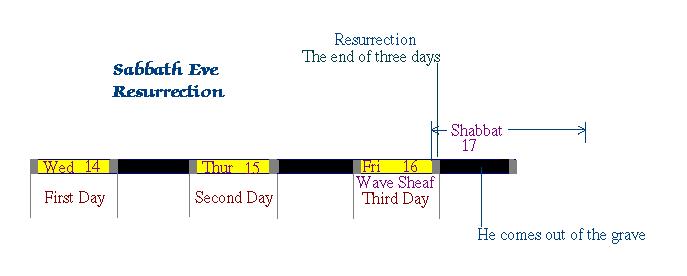
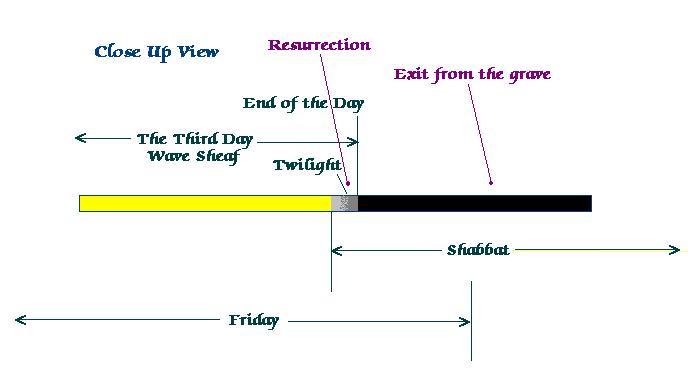
So, This view, may in fact, be the most literal view of all. It puts the resurrection exactly on the day of the wave sheaf, the first of 50 days to Shavuot; it does not require the use of the common day (sunrise to sunrise), but only the ber. 1:4 [Gen. 1:4] day. It requires no clash between 'after three days,' and 'the third day,' to be solved by two usages of 'day.' And seems to accord with previous usage of 'in the end of the third day' and 'while still yet the third day' (Yeh. 1:11, 3:2). It agrees with the strictest definition of 'day' as 'light,' and agrees with the strictest Jewish practice of inclusive counting. And it keeps Yayshua in the grave during the third night (Matthew 12:40). It puts the resurrection on the First of the Sabbaths, also called, "The Latter of the Sabbaths," or the "Second First Sabbath" (Luke 6:1).